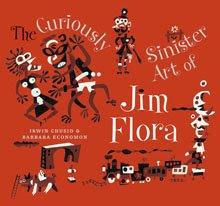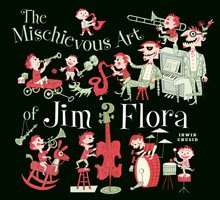
We launched our latest Jim Flora fine art print,
G3 in Tampico (detail, left), earlier this week. The original 1970 tempera painting on artist board is shelved in storage at the Flora collection in
Norwalk, Connecticut. The title is an enigma, but so are the figures
(full work below). Here's a peek at the selection and restoration process behind our fine art prints.
The Flora catalog is huge; as co-archivists,
Barb Economon and I have a growing list of works flagged for print production.
G3 was not on this list. Most original works on paper have been scanned at high resolution, and oversized canvases have been photographed. The digital files then undergo a carpal-straining restoration process to prepare the images for print media (e.g., books, paper goods, fine art prints). This process is the purview of Barb, a specialist in digital image technology. It's become obvious during our research in the collection that Flora was less than fastidious in the preservation of his past art during his lifetime. It's likely that the large volume of historical works balanced against the ongoing creation of new works left little time for the artist to focus on safeguarding his legacy. Sunlight, humidity, careless shelving, aging, and accidents, as well as adhesive stains, paper acidity, and nicotine smoke have all taken their toll. After Flora's death, his family placed the entire collection in safe,
climate-controlled storage (photo, lower left), where most of it remains to this day. The greater the deterioration of (or damage to) the original, the more restoration work is required.

A few weeks ago a small record label requested an image to license for a
CD cover. Reviewing hundreds of digital files, I discovered
G3 (previously unpublished and uncirculated) and sent the label a low-resolution jpg (along with a batch of additional images). On closer examination, I realized the image had not been restored. Strictly as a Zen exercise, I undertook some rudimentary cleanup over several days, and the figures began to percolate. I reached the limits of my restorative powers and turned the file over to Barb. She made additional corrections and adjustments, and decided to produce a test print. It was declared a masterwork, and we decided to issue an edition. The entire process from idle cleanup to print launch took four days.
Below is a before/after comparison of the images
(click to enlarge). The original is in bad shape — there are faded areas, soiling, paint loss, and moisture spots. It's amazing what you can accomplish with painstaking mouse-clicks.

I considered purchasing
G3 from the Flora family. However, considering the condition of the original, I opted for a print. The damaged work would be expensive to restore, and without professional restoration it will continue to deteriorate. (Its condition is effectively stabilized in limited light, climate-controlled storage.) The new print reflects the work much as Flora created it forty years ago, with a few minor aging artifacts.
 We recently opened a Jim Flora store at Etsy.com. For now, the shelves are merchandise-sparse, but more items will be added in the coming weeks. Current and future Etsy offerings are also available through our fine art prints gallery and our Little Shop of Flora's. Either place you purchase, the source is the same: us. We're also considering listing some exclusive items at Etsy.
We recently opened a Jim Flora store at Etsy.com. For now, the shelves are merchandise-sparse, but more items will be added in the coming weeks. Current and future Etsy offerings are also available through our fine art prints gallery and our Little Shop of Flora's. Either place you purchase, the source is the same: us. We're also considering listing some exclusive items at Etsy.

















